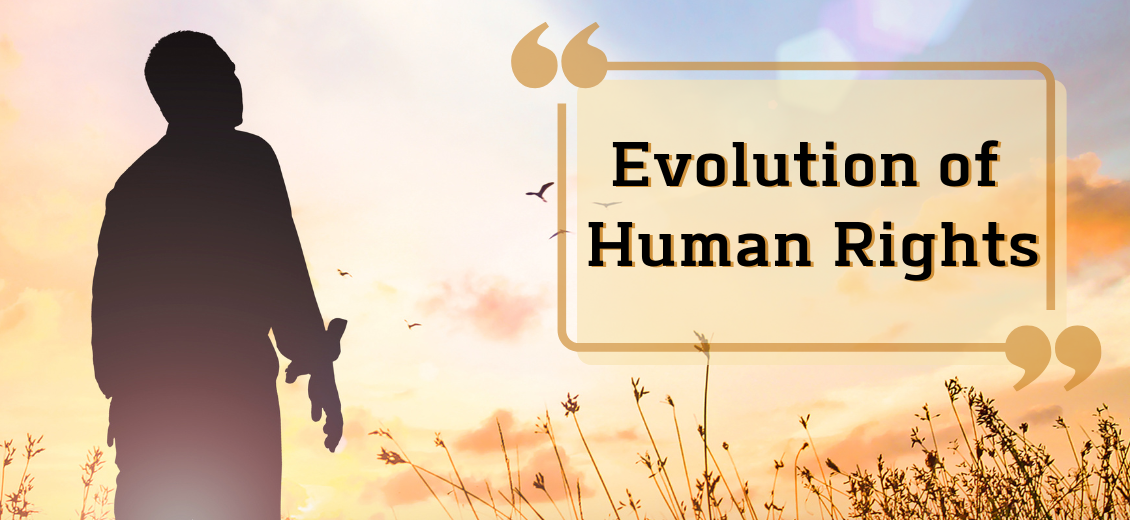Evolution of Human Rights
Blogs Home
- 27 Jul 2022

Introduction
Article 1 of the UN Declaration of Human Rights, 1948 reads "All human beings are born free and equal in dignity and rights". But what are human rights? What is the relevance of the term "human" in human rights? Are these universal? Why do they matter and how did these rights evolve? What is the relevance of such claims in the 21st century? These are only some of the many questions that I try to answer through this blog.
But before one can answer such complex questions, we need to understand the meaning of human rights.
What are Human Rights?
According to Andrew Heywood, the author of several political textbooks like Politics, political ideologies and global Politics, Human Rights are rights to which people are entitled by virtue of being human, they are a modern and secular version of "natural rights". There are four characteristics to define human rights.
First, they are universal. Human rights belong to everyone without discriminating against any particular race, religion, caste, creed and other such differences. Second, they are fundamental in the sense they are crucially important and are of prime importance. Third, they are absolute implication is that they are basic for each individual and fourth, they are indivisible. It means that all forms of human rights, be it civic, economic or social are of equal importance.
In simpler terms, the rights that each individual is entitled to as human beings, are referred to as human rights. The essential characteristic to remember about human rights is that they are universal and they are entitled to each human being regardless of their nationality, race, religion and so on.
Evolution of Human Rights and their types
The precise moment when the concept of Human Rights emerged is hard to pinpoint. Many cultures and traditional societies have believed in the worth every individual possesses as a human. Nevertheless, it was in early modern Europe when the idea of Human rights can be said to emerge in the form of "Natural Rights". The philosophers like John Locke, Thomas Hobbes, Hugo Grotius etc declared some rights as natural in the sense that they were fundamental to human beings and are the very core of human nature. However, few early contributions are considered important and seen as landmarks that led to the beginning of the fairly new concept of human rights.
Some of the major historical contributions include the Magna Carta of 1215, the Bill of Rights of 1688, the US Declaration of Independence of 1776, and the Rights of Man and the Citizen, 1789 France. These centuries witnessed the growth of humanitarian ethics and there were gradual attempts to introduce rights. For instance, the Congress of Vienna of 1815 tried to promote the abolishment of the slave trade which was eventually achieved by the Brussels Convention of 1890. Even when most of the contributions were championed by states for their own country and their own people, they laid the thrust of the language of rights.
Nevertheless, it was with the end of the two brutal world wars that the popularity of Universal Human Rights gathered momentum. In 1948, the United Nations adopted the Universal Declaration of Human Rights in its general assembly. In 1966, two major human rights documents were adopted, namely the International Covenant on Civil and Political Rights and the International Covenant on Economic, Social and Cultural Rights, both of which came into force in 1976.
Karel Vasak, a distinguished and very well-known human rights scholar, introduced the idea of three generations of human rights, which allows us to understand the types and evolution of human rights better. The first generation of human rights is civil and political rights. The second generation of human rights includes economic, social and cultural rights and the third generation of human rights are called solidarity rights.
The first generation rights i.e., civil and political rights are the initial form of natural rights. These rights developed during the English Revolution of the 17th century and the French and American Revolution of the 18th century. The key theme underlying these rights is liberty. The first generation rights include the right to life, the right to liberty, and the right to property and have expanded to include non-discrimination, freedom from arbitrary arrest, freedom of thought, freedom of religion, freedom of movement etc. These rights are often seen as a manifestation of negative rights since they can be enjoyed only when there is a restriction upon others. The key documents to understand the content of the first generation of human rights are Article 3 to Article 21 of the UN Declaration and the International Covenant of Civil and Political Rights of 1966 which came into force in 1976.
In the twentieth century, especially post World War II, second-generation rights began to earn a greater prominence. The economy of countries was torn by war and there was massive destruction as a result of the world wars. Therefore, the effort for economic, social and cultural rights developed during the twentieth century. The rights rely on socialist assumptions and the underlying theme is equality which is in contrast to first-generation rights and the notion of liberty. The second-generation rights include the right to work, the right to health care, the right to education, the right to social security etc. Therefore, these rights are seen as a manifestation of positive rights as they place a claim on the state and a duty to oblige for action, for example, welfare provisions. The key documents to understand the content of second-generation rights are Article 22 to Article 27 of the UN Declaration and the International Covenant of Economic, Social and Cultural Rights of 1966.
The third generation of rights emerged post-1945 and are referred to as solidarity rights. This is for the simple reason that these rights are concerned with social groups and society on the whole rather than an individual. They are therefore seen as collective rights. The underlying theme of the third-generation rights is fraternity. Usually, these rights are shaped by the difficulties faced by the countries of the Global South. These rights include the right to development, the right to environmental protection, the right to self-determination, the right to peace etc. The Stockholm Convention of Human Environment of 1972 and the Earth Summit of 1992 at Rio can be analysed to understand these rights.
Way Forward
Now that we know that Human rights are the basic rights that a person has as soon as he/she/they are born, hence we should try to be aware of our rights and use them wisely without compromising the human rights of other people as it can be registered as a human right violation.
Human rights have been interpreted by different communities and countries in different ways. As history took form over time, human rights have also gained new meanings and definitions. The notion of human rights has also been challenged at times. Major incidents have given rise to big debates surrounding the rights, the latest one being the revoking of the Right to Abortion that rested with American women before the Dobbs vs Jackson Women's Health Organization (2022) happened.
There is no saying what will be the future of human rights, but we can’t deny the fact that safeguarding these vital rights can help establish peace and restore people’s faith in humanity for sure.

Annie Pruthi
Annie Pruthi is currently pursuing her masters in Political Science from JMI, New Delhi and is a first division Arts graduate from Delhi University. She is an avid reader and an award-winning best-selling author. Her book "Will You Stay?" recently won the title of "Most Promising Book, 2020 (Fiction)" in the Coimbatore Literary Awards.
Blogs Home



